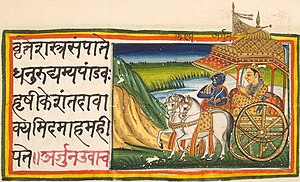Bhagavad Gita

The Bhagavad Gita, often referred to as the Gita, is a 700-verse Hindu scripture that is part of the Indian epic Mahabharata. It is a sacred text of the Hindu religion and is considered one of the most important spiritual classics in the world. The Bhagavad Gita presents a synthesis of Hindu ideas about dharma, theistic bhakti, and the yogic ideals of moksha.
Authorship and Dating[edit | edit source]
The Bhagavad Gita is traditionally attributed to the sage Vyasa, who is also credited with composing the Mahabharata. The exact date of the composition of the Gita is uncertain, but it is commonly believed to have been written between the 5th and 2nd centuries BCE.
Content[edit | edit source]
The Bhagavad Gita takes the form of a dialogue between Prince Arjuna and the god Krishna, who serves as his charioteer. The dialogue takes place on the battlefield of Kurukshetra just before the start of a great war. Arjuna is filled with doubt and moral dilemma about fighting in the war, and he turns to Krishna for guidance.
The Gita covers a wide range of topics, including duty (dharma), righteousness, the nature of reality, the self, and the ultimate goal of life. Krishna teaches Arjuna various paths to spiritual realization, including karma yoga (the yoga of action), bhakti yoga (the yoga of devotion), and jnana yoga (the yoga of knowledge).
Key Concepts[edit | edit source]
1. Dharma: The central theme of the Bhagavad Gita is the concept of dharma, which refers to one's duty or righteousness. Krishna emphasizes the importance of performing one's duty without attachment to the results, as this leads to spiritual growth and liberation.
2. Yoga: The Gita describes different paths of yoga as means to attain spiritual realization. These paths include karma yoga (selfless action), bhakti yoga (devotion), and jnana yoga (knowledge).
3. The Self: The Gita teaches that the true self (atman) is eternal and unchanging, while the body is temporary and perishable. Realizing the true nature of the self leads to liberation (moksha) from the cycle of birth and death.
4. The Nature of Reality: Krishna explains the concept of Brahman, the ultimate reality that pervades everything in the universe. He also discusses the transient nature of the material world and the eternal nature of the spiritual realm.
Influence[edit | edit source]
The Bhagavad Gita has had a profound influence on Hindu philosophy, spirituality, and culture. It has been studied and revered by scholars, philosophers, and spiritual seekers for centuries. The Gita's teachings on duty, righteousness, and the pursuit of spiritual knowledge continue to inspire millions of people around the world.
The Bhagavad Gita has also been widely translated into various languages and has been studied and admired by people of different religious and cultural backgrounds. Its universal message of peace, duty, and spiritual wisdom transcends religious boundaries and speaks to the human condition.
The Bhagavad Gita is a timeless spiritual classic that offers profound insights into the nature of reality, the self, and the ultimate goal of life. Its teachings on duty, righteousness, and the pursuit of spiritual knowledge continue to inspire and guide people on their spiritual journey. As one of the most important scriptures of Hinduism, the Bhagavad Gita holds a revered place in the hearts of millions of people around the world.